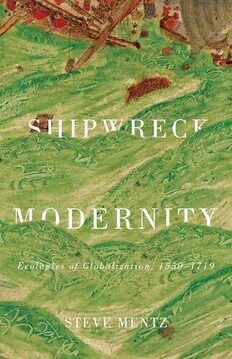
Shipwreck Modernity: Ecologies of Globalization, 1550–1719 PDF
Preview Shipwreck Modernity: Ecologies of Globalization, 1550–1719
SHIPWRECK MODERNITY This page intentionally left blank Shipwreck Modernity . . . . Ecologies of Globalization, 1550– 1719 Steve Mentz University of Minnesota Press Minneapolis London Portions of chapter 1 were published as “God’s Storms: Shipwreck and the Meanings of Ocean in Early Modern England and America,” in Shipwreck in Art and Literature: Images and Interpretations from Antiquity to the Present Day, ed. Carl Thompson, 77–9 1 (London: Routledge, 2014); reprinted by permission of Taylor and Francis Group, a division of Informa. Portions of chapters 5 and 7 were published as “ ‘Making the Green One Red’: Dynamic Ecolo- gies in Macbeth, Edward Barlow’s Journal, and Robinson Crusoe,” JEMCS 13, no. 3 (Summer 2013): 66– 83. Portions of chapter 6 were published as “Donne at Sea: The Islands Voyage and Poetic Form,” Forum for Modern Language Studies 49, no. 4 (2013): 355– 68. Portions of chapter 7 were published as “Shipwreck,” in Inhuman Nature, ed. Jeffrey Jerome Cohen, 1– 15 (Brooklyn, N.Y.: Punctum Books, 2014). William Carlos Williams, “The Seafarer,” from The Collected Poems, Volume II: 1939–1 962 (New York: New Directions Publishing, 1948). Reprinted by permission of New Directions Publishing. George Oppen, “Of Being Numerous,” from New Collected Poems (New York: New Directions Publishing, 1968). Copyright 1968 by George Oppen. Reprinted by permission of New Directions Publishing. Copyright 2015 by the Regents of the University of Minnesota All rights reserved. No part of this publication may be reproduced, stored in a retrieval system, or transmitted, in any form or by any means, electronic, mechanical, photocopying, recording, or otherwise, without the prior written permission of the publisher. Published by the University of Minnesota Press 111 Third Avenue South, Suite 290 Minneapolis, MN 55401-2 520 http://www.upress.umn.edu Library of Congress Cataloging-in-Publication Data Mentz, Steve. Shipwreck modernity: ecologies of globalization, 1550–1719 / Steve Mentz. Includes bibliographical references and index. isbn 978-0-8166-9103-6 (hc) ISBN 978-0-8166-9106-7 (pb) 1. Shipwrecks in literature. 2. Literature and society—History. 3. Ecology in literature. 4. Civilization, Modern, in literature. 5. Shipwreck survival in literature. I. Title. PN56.S54M46 2015 809'.93355—dc23 2014049432 Printed in the United States of America on acid- free paper The University of Minnesota is an equal-opportunity educator and employer. 21 20 19 18 17 16 15 10 9 8 7 6 5 4 3 2 1 For Alinor, Ian, Olivia, and the global ocean This page intentionally left blank Contents Two Prefaces Theoretical Preface: Epochal Claims and the Age of Shipwreck ix Narrative Preface: Ulysses and the Global Ecology xxiii 1. The Wet and the Dry: Shipwreck Hermeneutics 1 2. Angry Gods: Theologies of the Ocean 25 3. Isle of Tempests: Bermuda in the Early Modern Imagination 51 Interchapter: Pearls That Were His Eyes 75 4. Metis: Jeremy Roch 77 5. Metis: Edward Barlow 103 Interchapter: Philosopher at the Masthead 129 6. “We Split”: Sea Poetry and Maritime Crisis 131 7. Castaways: Surviving Disaster 161 Three Short Epilogues The Bright Light of Shipwreck 177 The Bookfish 178 Seven Shipwrecked Ecological Truths 180 Acknowledgments 183 Notes 185 Index 215 This page intentionally left blank Two Prefaces This book about disaster starts with a theoretical preface and a narrative preface. Theory and story together assemble errancy into form. Theory gazes down at catastrophe from above, rearranging chaos into order. Story reassembles the broken pieces through the friction of proximity, piling events upon events. This book’s response to disaster employs the perspective of theory and the continuity of story. If it were possible, I would ask you to read both prefaces at the same time, combining theory and story. It takes the resources of both modes to explain shipwreck’s global modernity. But since full simultaneity is not possible, since reading of necessity involves the linear act of moving forward from word to word and page to page, I offer these twin prefaces as Pillars of Hercules framing the entrance into rough seas. By way of invitation: nec plus ultra. Theoretical Preface: Epochal Claims and the Age of Shipwreck The big fish at which the theoretical preface gives up its spear is an eco- logical theory of historical change. Shipwreck sits at the center of this theory creating disorderly rupture. Crafting a flexible historical lan- guage to make sense of continuity and change requires complex, un- stable, semipredictable systems. I start with two mutually implicated models for how historical systems alter: theft and composture. I em- phasize the second but start with the first. Theft characterizes the key transaction hidden inside familiar just- so stories about historical breaks. These events are often imagined as pro- ductive ruptures out of which some brand- new thing springs, armed and ready for combat. My polemical description of “break history” as theft recalls a long-l ived caricature of a modernity that gives birth to itself by stealing from classical antiquity. This familiar story undergirds · ix ·
